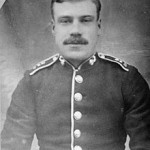The Battle of Mons marked the first battle between the British & German Armies in the First World War. It was a titanic struggle that threatened to completely overwhelm the small professional British Army in the hot summer of 1914.
THE WAR BEGINS
In 1914 Britain was primarily a sea power and only maintained a very small professional Army. Britain declared war against Germany after Germany violated Belgian neutrality in 1914 when they invaded Belgium, a country Britain was obliged to protect by treaty. A small British expeditionary force (BEF) initially numbering only about 80,000 soldiers was sent to northern France, arriving on August 14, whilst the German Army in total numbered over a million men.
THE BRITISH ARRIVE IN FRANCE
The BEF, under its Commander-in-Chief, Sir John French planned to meet up with the French Fifth Army near Charleroi. However before reaching Charleroi, the BEF encountered cavalry patrols from the German First Army at Soignies on 22 August. The BEF changed tack overnight, and French ordered his five divisions to establish defensive positions at the nearby Mons Canal, unaware of the full strength and recent victories of the Germany Army facing him. 68,000 Tommies were about about to face a tidal wave of nearly 160,000 German troops along with 300 Royal Artillery guns against 600 German. The skill, courage and training of the BEF was to provide vital if this tiny force wasn’t to be overwhelmed.
BATTLE IS JOINED
The initial German action led by the German commander,von Kluck, against the BEF, began on 23rd August 1914 and went disastrously for the Germans, the British riflemen exacting heavy losses from the advancing German infantry. The efficiency of the British riflemen was such that von Kluck assumed that the enemy were using machine-guns.
Von Kluck then paused the attack in order to draft in reserves. The French Armies to the BEF’s right began a retreat so the British then began a strategic retreat to a second line of defence.
Von Kluck did not at first give chase, choosing instead to address the heavy casualties inflicted earlier in the day. Ultimately however he inflicted almost 8,000 casualties upon the British rear-guard at the Battle of Le Cateau on 26 August.
The BEF then began an exhausting retreat back to the River Marne some 250 miles away where the allies would turn and face down the German juggernaut, save Paris and push the German invaders back.
During the retreat the tiny BEF remained in contact with both the French Armies and enemy forces. Discipline and courage saved the BEF from total annihilation. Like Dunkirk 26 years later this was not a victory but a deliverance brought about by the pluck and courage of the British Tommy.
MONS, THE RETREAT & THE BATTLE OF THE MARNE PHOTO GALLERY
Click on an image below to display it in full.
























You must be logged in to post a comment.